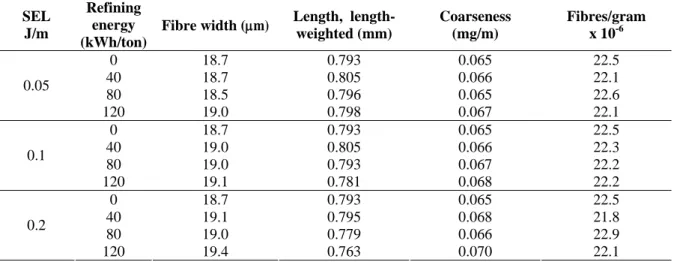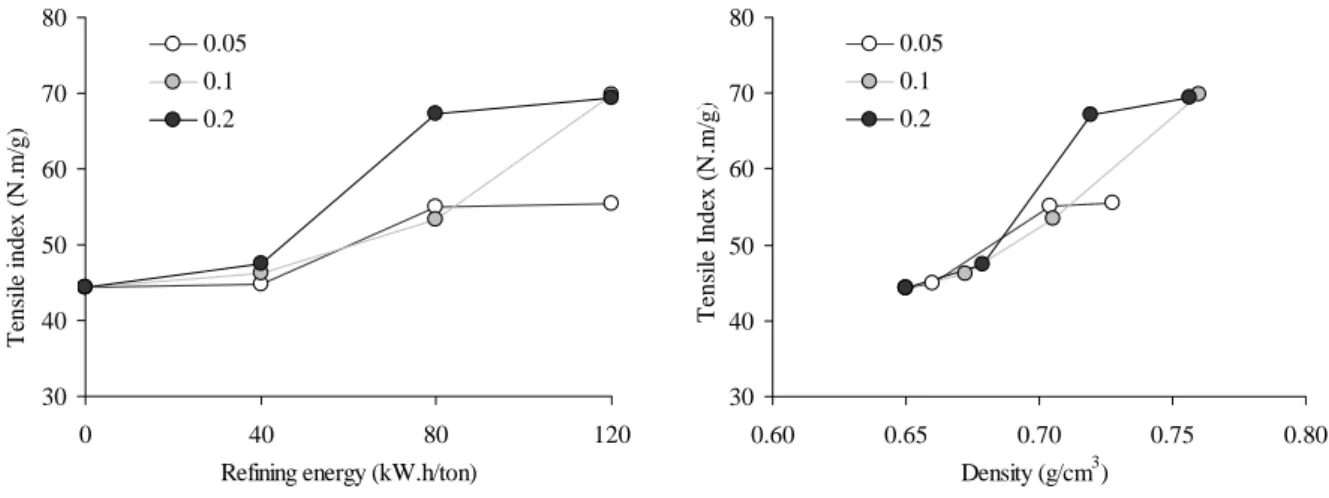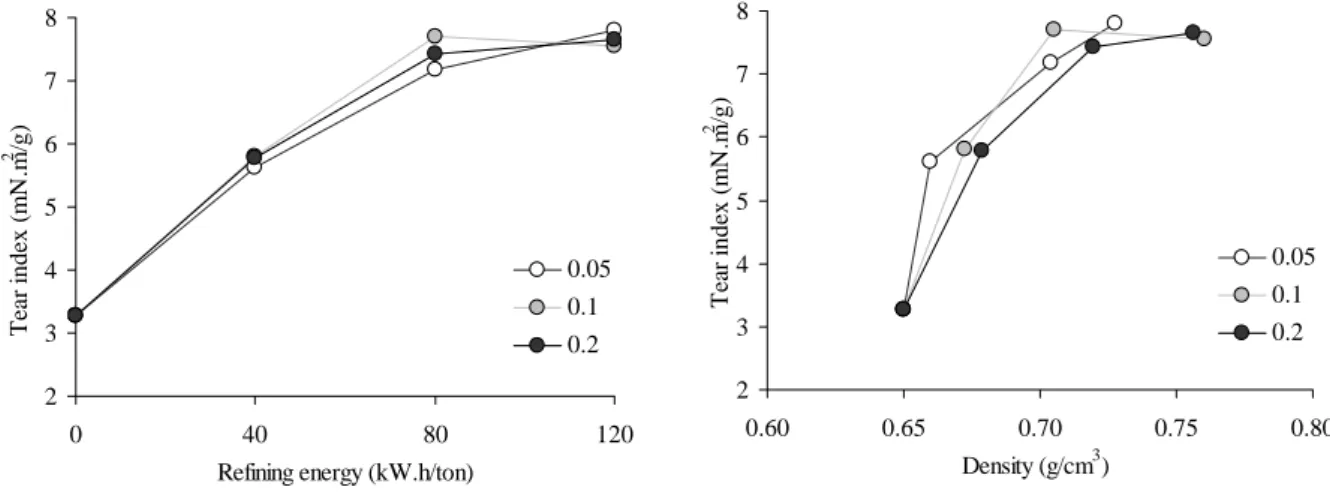EFFECT OF SPECIFIC EDGE LOAD ON Eucalyptus globulus PAPER
PROPERTIES
Carla Peralta1, Elisabete Piçarra1, António Santos2, Ofélia Anjos1,3 and Rogério Simões2
1
Superior Agrarian School of Castelo Branco, Quinta da Senhora de Mércules, Apartado 119 – 6001 Castelo Branco – Portugal.
2
Research Unit of Textile and Paper Materials, Beira Interior University, 6201-001 Covilhã – Portugal
3
Forestry study research center - Instituto Superior de Agronomia – 1300 Lisboa, Portugal
SUMMARY
Refining is an important unit operation in the paper production process and consists in the mechanical beating of the pulp fibres in an aqueous medium. The refining conditions affect fibre morphology, pulp suspension characteristics and paper properties.
In this study we investigated the effect of refining intensity - given by the specific edge load (SEL) - on the fibre and paper properties. Lower refining intensity led to lower fibre cutting, lower fines generation, and lower ºSR development. Commercial Eucalyptus globulus bleached pulp was refined in a pilot refiner, using different specific edge loads (0.05; 0.1 and 0.2 J/m) and specific energy consumption of 40, 80 and 120 kWh/ton in order to evaluate paper potential.
The highest specific edge load tested (0,2 J/m) resulted in a lower average fibre length, as a result of a higher fibre cutting. The papers produced presented higher mechanical resistance, but increasing refinement energy from 80 to 120 kWh/ton did not improve paper properties. On the contrary, with a lowest specific edge load (0,05 J/m), the papers obtained for different specific energy consumption exhibited lower density (i.e., higher open structure, higher air permeability and lower smoothness).
Key words: specified edge load, energy consumptions, Eucalyptus
globulus, paper potential.
INTRODUCTION
Refining consists in the mechanical beatingof the pulp fibres in an aqueous medium to give them flexibility, collapsibility and capacity to establish bonds connecting the fibres which others and to give to the paper good quality and good resistance (Kerekes, 2005).
The main objective of the beating is to break the commanded structure of the fibres, in order to make accessible more hydroxyl’s groups, which increase the fibre potential for creating chemical bonds. This treatment is usually divided in three phases: hydration, fibrillation and finally the cut (Seth, 1999). Refining affects swelling (internal fibrillation), fibre straightening (or curling), external fibrillation, fibre cutting, fines production, fibre collapsibility, kinks, dissolution of colloidal material, redistribution of hemicelluloses and formation of gelatinous surface (Stone et al. 1968, Mohlin and Wennberg 1984, Page 1989, Paavilainen 1993, Maloney 2000). Moreover, internal fibrillation is often considered as the most important beating effect.
Beating pulp process aims to improve the runnability-related strength properties of paper, by increasing the bonding ability of the fibres (Hiltunen, 2003). Certain paper properties, like optical parameters, decrease during beating. Out-of-plane tear and in-plane tear strength typically first increase, reach a maximum and then decrease (Van den Akker et al. 1967, Seth and Page 1988, Seth 1999, Santos et al. 2006). Refining makes also, more difficult to remove water in the paper machine. So, refining is always a compromise between the desired and undesired effects (Hiltunen, 2003).
In this study we investigated the effect of refining intensity - given by the specified edge load (SEL) - on the fibre and paper properties of Eucalyptus globulus kraft pulp.
MATERIALS AND METHODS
The pulp used is a commercial E. globulus kraft bleached pulp obtained from a Portuguese pulp mill. The refining study was carried out in a pilot refiner (Andritz Sprout-Bauer). Three kg of pulp was refined under recycling conditions until the required specific energy consumption was achieved. The energy levels tested were 40, 80 and 120 kWh/ton. Three refining intensities (SEL) were also investigated: 0.05, 0.1 and 0.2 J/m, for each energy consumption level.
The morphological properties of pulp fibres were determined automatically by image analysis of a diluted suspension (20 mg/L) in a flow chamber in Morfi®.
Paper handsheets were prepared according to the Scan standard, and tested regarding structural, mechanical and optical properties.
RESULTS AND DISCUSSION
Table 1 shows the biometric characteristics of the fibres for the three SEL conditions and the different specific energy consumption used in this study. When we use a higher SEL the fibre length are significantly smaller than for the case where the SEL is lower, which suggest greater cut on the fibre. The SEL or the specific energy consumption didn’t significantly affect the coarseness.
Table 1 – Pulp fibre pulps characteristics. SEL J/m Refining energy (kWh/ton)
Fibre width (μm) Length,
length-weighted(mm) Coarseness (mg/m) Fibres/gram x 10-6 0 18.7 0.793 0.065 22.5 40 18.7 0.805 0.066 22.1 80 18.5 0.796 0.065 22.6 0.05 120 19.0 0.798 0.067 22.1 0 18.7 0.793 0.065 22.5 40 19.0 0.805 0.066 22.3 80 19.0 0.793 0.067 22.2 0.1 120 19.1 0.781 0.068 22.2 0 18.7 0.793 0.065 22.5 40 19.1 0.795 0.068 21.8 80 19.0 0.779 0.066 22.9 0.2 120 19.4 0.763 0.070 22.1
Figure 1 represents the drainability resistance data for the three series of refining. The fibres refined under the lowest SEL exhibit the lowest drainability resistance, probably because the external fibrillation and the fine generation are lower.
The effect of beating on paper density (Figure 2) reveals that papers with lower density were obtained when the pulp was refined under lower SEL (0.05 J/m), which is in according to the ºSR results. For all SEL levels, we can see an increment of the paper density with the beating energy, what is an expected result.
Figure 3 (a) shows that the paper produced with higher specified edge load exhibit a higher tensile strength resistance for all beating energy levels. The results for tensile and burst are mainly justified by the differences in both density and internal cohesion of the papers produced from the different pulps. However, the representation of tensile strength as a function of paper density (Figure 3-b) reveals that E. globulus refined with a higher specified edge load can produce stronger papers than the pulp suspensions refined under lower refining intensities. 0 20 40 60 80 0 40 80 120
Refining energy (kW.h/ton)
ºSR
0.05 0.1 0.2
Figure 1: Variation of the Schopper Riegler degree
(ºSR) with refining energy, for the E. globulus pulps refining at three different SEL levels.
0.60 0.65 0.70 0.75 0.80 0 40 80 120
Refining energy (kW.h/ton)
D en sity ( g /c m 3 ) 0.05 0.1 0.2
Figure 2: Variation of paper density with beating
energy, for the E. globulus pulps refining at three different SEL levels.
30 40 50 60 70 80 0.60 0.65 0.70 0.75 0.80 Density (g/cm3) T ens il e I nde x ( N .m /g) b 0.05 0.1 0.2 30 40 50 60 70 80 0 40 80 120
Refining energy (kW.h/ton)
T ens il e i ndex ( N .m /g) (N . 0.05 0.1 0.2
Figure 3: Variation of tensile index with beating energy (a-left) and paper density (b-right), for the E. globulus
pulps refining at three different SEL levels.
In Figure 4 was represented the variation of zero-span tensile strength, dry and wet, with beating energy. There are significative differences between the different specified edge loads applied. For the lower SEL the dry zero span increase with the increasing of the beating energy but for all other pulp, wet and dry, the variation is inverse. Both, the higher curl of the fibres and the kinks imposed by higher energy impacts can justify the observed behaviour.
110 130 150 170 190 210 0 40 80 120
Refining energy (kW.h/ton)
Te n sile z e ro s p a n ( N .m /g ) (N . 0.05 0.1 0.2 Dr y Wet
Figure 4: Variation of zero-span tensile strength, dry and wet with beating energy, for the E. globulus pulps refining at three different levels.
Concerning tearing resistance (Figure 5), all the pulps show a similar behaviour, independent of the SEL, with the beating energy. When we represent the tear index as a function of paper density we can see that, for the same paper density, the refining with higher SEL can lead to smaller tear index values.
2 3 4 5 6 7 8 0.60 0.65 0.70 0.75 0.80 Density (g/cm3) T ea r i nde x (m N .m 2 /g ) 0.05 0.1 0.2 2 3 4 5 6 7 8 0 40 80 120
Refining energy (kW.h/ton)
T ear i nde x ( m N .m 2 /g ) (N . 0.05 0.1 0.2
Figure 5: Variation of tear index with beating energy (a-left) and paper density (b-right), for the E. globulus pulps refining at three different SEL levels.
In Figure 6, tear index is reported as a function of tensile index. We can observe a superiority of the pulp refined with the specific edge load of 0.1 J/m. In addition, when both tensile and tear strength are important in the paper uses, the refining under 0.1 J/m can be the best choice. However, more experimental work, particularly more energy levels should be tested in order to evaluate this hypothesis.
2 3 4 5 6 7 8 40 50 60 70 Tensile index (Nm/g) T ea r i nde x ( m N .m 2 /g ) (N . 0.05 0.1 0.2
Figure 6: Variation of tear index as a function of tensile index.
CONCLUSIONS
In the range of specific edge load (SEL) between 0.05 and 0.2 J/m, the average fibre length slightly decreases with the SEL, for the highest specific energy consumption. These experimental results suggest higher fibre cutting. The external fibrillation and fine generation are also favoured, which leads to higher drainage resistance, but also denser paper. The papers produced under 0,2 J/m exhibit higher mechanical resistance, but the increase of refinement energy from 80 to 120 kWh/ton did not improve paper properties. The tear
resistance seems to be negatively affected by the highest SEL level. The experimental results suggest that intermediate SEL can be the best refining conditions. However, this hypothesis is yet under investigation.
REFERENCES
Hiltunen E 2003: On the beating of reinforcement pulp: Dissertation for the degree of Doctor of Science in Technology, Helsinki University of Technology, Laboratory of Paper Technology.
Kereques RJ 2005: Characterizing refining action in PFI mills. Peer-reviewed refining: Tappi Journal Vol. I4 (3): 9-13
Maloney TC 2000: On the Pore Structure and Dewatering Properties of the Pulp Fiber Cell Wall: D.Sc. (Tech.) thesis, Helsinki University of Technology, Department of Forest Products Technology
Mohlin UB Wennberg K 1984: Some aspects of the interaction between mechanical and chemical pulps: Tappi Journal 67(1): 90-93.
Paavilainen L 1993: Conformability - flexibility and collapsibility - of softwood sulphate pulp fibres. Paperi ja Puu 75: 689-702.
Page DH 1989: The beating of chemical pulps- the action and the effects: Fundamentals of papermaking: transactions of the ninth fundamental research symposium, London, Cambride.
Santos A Anjos O Simões R 2006: Paper making potencial of Acacia dealbata and Acacia
melanoxylon: APPITA journal 59(1):58-64
Seth RS 1999: Beating and refining response of some reinforcement pulps: Tappi Journal, 82(3), 147-155
Seth RS Page DH 1988: Fiber properties and tearing resistance: Tappi Journal 71(2): 103-107 Stone JE Scallan AM Abrahamson B 1968: Influence of beating on cell wall swelling and
internal fibrillation: Svensk Pappertidning 19(10): 687-694
Van den Akker JA Wink WA Van Eperen RH 1967: Instumentation studies LXXXIX. Tearing strength of paper. III. Tearing resistance by the in-plane mode of tear: Tappi 50(9): 466-470


